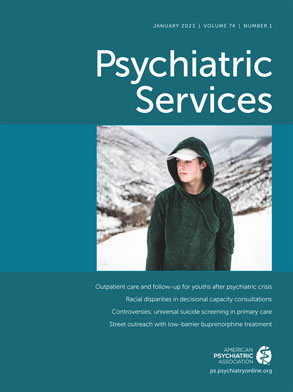The overrepresentation of individuals with mental illness in the criminal legal system is a well-known crisis worthy of psychiatry’s collective efforts and energy. The past several decades have seen an increase in scholarship attempting to better understand this phenomenon and the efforts to counteract it, primarily through the conceptual framework of the sequential intercept model. Multiple interventions have been developed to reduce this overrepresentation and criminalization of mental illness, including crisis intervention teams (CITs), forensic assertive community treatment teams, mental health and drug courts, and other types of diversionary programs. These efforts have had varying levels of success, but challenges remain, and understanding the criminal legal impact of such interventions on specific populations requires further attention.
In this issue, Compton et al. (
1) describe their study of arrest data for New York State from 2010 to 2013, comparing charges involving individuals with and without serious mental illness. The authors used Medicaid billing and state hospital admission and discharge records as indicators of severe mental illness and examined the percentage of individuals arrested for a violent crime, penal code classification, Uniform Crime Reporting codes, and the most common specific charges between groups. Compton et al. found that arrests of individuals with serious mental illness were less likely to be categorized as a violent offense, and most arrests of those with serious mental illness were for nonviolent crimes. Class A misdemeanors were substantially more common in arrests of individuals with serious mental illnesses, whereas unclassified misdemeanors (driving while intoxicated, with a suspended license, or recklessly) were less common. Larceny and criminal trespass were two of the most common charges for individuals with serious mental illness.
The study affirms and extends key concepts previously demonstrated in the literature exploring the intersection of public-sector mental health and the criminal legal system. The finding that individuals with mental illness were less likely to be arrested for violent offenses furthers the growing evidence disproving the stigmatizing myth that connects mental illness to increased risk for violence. The authors raise a key point—that police officers’ discretion when choosing whether to arrest on misdemeanor charges (vs. pursuing a diversionary pathway) can have compounding effects on an individual’s involvement with the criminal legal system and subsequent risk of recidivism. The charges for which individuals with mental illness were most frequently arrested (larceny and criminal trespass) also suggest that the sociocultural circumstances of this population (i.e., poverty, housing instability) drive the behaviors that lead to subsequent arrest, rather than simply reflecting symptoms of their illness. Compton et al. highlight this point in describing the devastating synergistic effects of both the criminogenic risk and criminalization perspectives: “individuals with serious mental illnesses are, by virtue of their psychosocial circumstances, at high risk for behaviors qualifying as criminal offenses, and simultaneously, the criminal legal system readily uses its processes to control those behaviors that the community or complainants insist be controlled.”
These results raise important questions regarding public policy and resource allocation focused on reducing the overrepresentation of this population in our criminal legal system. If a state like New York, which has been at the forefront of several initiatives aimed to counteract such problems (e.g., mental health courts, CIT, involuntary outpatient commitment), continues to face such challenges, perhaps such efforts have reached a saturation point of effectiveness. This is not to say that these efforts have been ineffective or that funding should be diverted from these programs. However, increased expenditures could be shifted toward initiatives that more specifically focus on the social determinants of health and criminogenic risks that drive the behaviors leading to these arrests. For example, could greater focus and funding of evidence-based recovery-oriented interventions such as supported employment and housing, vocational training, and peer support have additive benefits in reducing rates of arrest for criminal trespass and larceny (compared to pouring more resources into criminal legal diversion)? Notably, Compton et al. did not explore or control for race and ethnicity in their study. Given what is known about the overrepresentation of minoritized populations among those with serious mental illness, readers may wonder how racism and other forms of prejudice may affect the findings. Compton et al.’s work suggests that both variables may be fruitful areas for further exploration.

